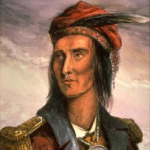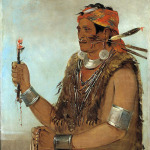“In any case they shall hereafter form any combination of a hostile nature… they will be driven beyond the great waters, and never again permitted to live within the Jurisdictional limits of the United States.”
–Secretary of War William Eustis, letter to Governor William H. Harrison
Part of the staff ride approach includes understanding the individuals who were important to the outcome of a campaign or battle. Why did they make a particular decision? All sorts of factors impact our decisions–fatigue, education, and training are just a few examples. The biographical sketch is a tool that is used during staff rides. The sketches provide insight, for staff ride participants, into the decision-making of combatants.
“Nothing now remains but to chastise him [the Prophet] and he shall certainly get it.”
–Governor William H. Harrison, letter to Secretary of War William Eustis
William Henry Harrison (1773-1841)
 Known as “Old Tippecanoe,” he was commander-in-chief of the Indiana militia and overall commander of all military forces engaged at the Battle of Tippecanoe. Commissioned as an ensign in 1791, he served as Major General Anthony Wayne’s aide-de-camp at the Battle of Fallen Timbers in 1794. He resigned from the army in 1798. He was appointed as the first secretary to the Northwest Territory in 1798, became the territory’s representative to Congress in 1799, and was appointed governor of the Indiana Territory in 1800. After the Battle of Tippecanoe, Harrison was the commander-in-chief in the Old Northwest during the War of 1812. Tecumseh was allied with the British during the war and was killed by Harrison’s forces during the Battle of the Thames. Harrison resigned from the army in 1814 and returned to politics. His political career culminated in his winning the 1840 presidential election. Harrison was president from March 4, 1841 to April 4, 1841, when he died in office. Harrison County, Indiana, was organized in his honor in 1808.
Known as “Old Tippecanoe,” he was commander-in-chief of the Indiana militia and overall commander of all military forces engaged at the Battle of Tippecanoe. Commissioned as an ensign in 1791, he served as Major General Anthony Wayne’s aide-de-camp at the Battle of Fallen Timbers in 1794. He resigned from the army in 1798. He was appointed as the first secretary to the Northwest Territory in 1798, became the territory’s representative to Congress in 1799, and was appointed governor of the Indiana Territory in 1800. After the Battle of Tippecanoe, Harrison was the commander-in-chief in the Old Northwest during the War of 1812. Tecumseh was allied with the British during the war and was killed by Harrison’s forces during the Battle of the Thames. Harrison resigned from the army in 1814 and returned to politics. His political career culminated in his winning the 1840 presidential election. Harrison was president from March 4, 1841 to April 4, 1841, when he died in office. Harrison County, Indiana, was organized in his honor in 1808.
“He [the president] is so far off he will not be injured by the war; he may sit in his town and drink his wine, while you and I have to fight it out.”
–Tecumseh, remark to Governor William H. Harrison
Tecumseh [Techumthe, Tecumtha] (ca. 1768-1813)
 The Shawnee warrior that organized the Indian confederacy engaged by General Harrison’s forces at the Battle of Tippecanoe. In 1794, Tecumseh led a war party against General Wayne’s forces at the Battle of Fallen Timbers. After the Indian defeat at Fallen Timbers, he refused to attend the peace council at Greenville. Tecumseh was not at the Battle of Tippecanoe; at the time, he was traveling in the area that is now the southern United States attempting to recruit Creek Indians and other tribes for his confederacy. He returned to Tippecanoe in February or March 1812, where he discovered that his brother, the Prophet, against his express orders, had attacked Harrison’s force. He allied himself with the British after the Battle of Tippecanoe and led Indian forces in Canada and the American northwest during the War of 1812. He was killed at the Battle of the Thames by forces under the command of Harrison. Throughout his adult life, he was well-known and respected as an orator, political organizer, and war leader.
The Shawnee warrior that organized the Indian confederacy engaged by General Harrison’s forces at the Battle of Tippecanoe. In 1794, Tecumseh led a war party against General Wayne’s forces at the Battle of Fallen Timbers. After the Indian defeat at Fallen Timbers, he refused to attend the peace council at Greenville. Tecumseh was not at the Battle of Tippecanoe; at the time, he was traveling in the area that is now the southern United States attempting to recruit Creek Indians and other tribes for his confederacy. He returned to Tippecanoe in February or March 1812, where he discovered that his brother, the Prophet, against his express orders, had attacked Harrison’s force. He allied himself with the British after the Battle of Tippecanoe and led Indian forces in Canada and the American northwest during the War of 1812. He was killed at the Battle of the Thames by forces under the command of Harrison. Throughout his adult life, he was well-known and respected as an orator, political organizer, and war leader.
“The Prophet told his followers that his medicine would make the white men’s weapons harmless and that bullets would pass harmlessly through the warriors.”
–To Compel With Armed Force
Tenskwatawa (ca. 1774-1834)
 Known as “The Prophet,” he led the Indian forces at the Battle of Tippecanoe. Tenskwatawa was not a war chief or leader but a spiritual leader for the members of the confederacy organized and led by his brother, Tecumseh. Tenskwatawa authorized the attack at Tippecanoe against the express orders of his brother, who was away recruiting other tribes for the confederacy. To Americans, Tenskwatawa was known as “The Prophet” or “The Shawnee Prophet.” He lost his right eye as a youth while practicing with a bow and arrow. As a young man, he was known as a drunk. He eventually reformed himself and created a religious cult. He rose to prominence among Indians after the death of an old Shawnee prophet in 1805. Tenskwatawa’s teachings emphasized a return to the Indians’ traditional lifestyle. Disavowed by Tecumseh after the defeat at Tippecanoe, Tenskwatawa allied himself with the British and wandered throughout the American northwest and Canada. In 1815, he and a small band of his followers moved to Missouri and then to Wyandotte County, Kansas, in 1828. He was a pensioner of the British government as a reward for his loyalty during the War of 1812.
Known as “The Prophet,” he led the Indian forces at the Battle of Tippecanoe. Tenskwatawa was not a war chief or leader but a spiritual leader for the members of the confederacy organized and led by his brother, Tecumseh. Tenskwatawa authorized the attack at Tippecanoe against the express orders of his brother, who was away recruiting other tribes for the confederacy. To Americans, Tenskwatawa was known as “The Prophet” or “The Shawnee Prophet.” He lost his right eye as a youth while practicing with a bow and arrow. As a young man, he was known as a drunk. He eventually reformed himself and created a religious cult. He rose to prominence among Indians after the death of an old Shawnee prophet in 1805. Tenskwatawa’s teachings emphasized a return to the Indians’ traditional lifestyle. Disavowed by Tecumseh after the defeat at Tippecanoe, Tenskwatawa allied himself with the British and wandered throughout the American northwest and Canada. In 1815, he and a small band of his followers moved to Missouri and then to Wyandotte County, Kansas, in 1828. He was a pensioner of the British government as a reward for his loyalty during the War of 1812.
The information on this page includes excerpts of biographical sketches in To Compel With Armed Force. Complete citations and references are available in the book. The images of Harrison, Tecumseh, and Tenskwatawa are in the public domain.


